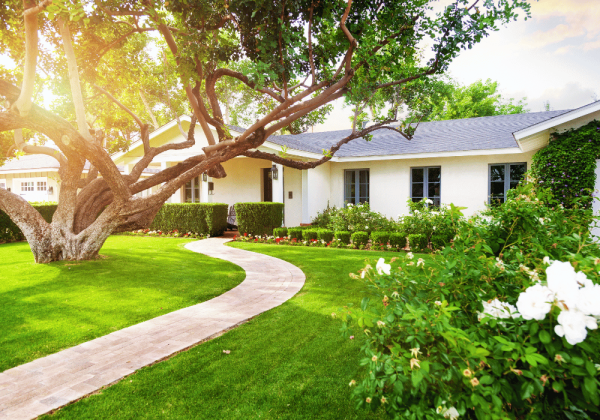Landscaping, at its core, is much more than just planting a few flowers or trimming some hedges. It’s an art form and a science that involves the thoughtful and deliberate transformation of outdoor spaces to create environments that are not only aesthetically pleasing but also functional and sustainable. In this comprehensive guide, we’ll explore the multifaceted world of landscaping, shedding light on its importance, components, benefits, and how you can get started with your landscaping project.
The Essence of Landscaping
 Landscaping encompasses a wide range of activities, from basic garden maintenance to elaborate design projects that can completely transform the look and feel of a property. At its essence, landscaping involves the planning, designing, and managing of living spaces outdoors. This can include gardens, backyards, patios, and any outdoor area that forms part of a property’s environment. The ultimate goal? To create harmonious, functional, and beautiful outdoor living areas that enhance the overall quality of life for those who use them.
Landscaping encompasses a wide range of activities, from basic garden maintenance to elaborate design projects that can completely transform the look and feel of a property. At its essence, landscaping involves the planning, designing, and managing of living spaces outdoors. This can include gardens, backyards, patios, and any outdoor area that forms part of a property’s environment. The ultimate goal? To create harmonious, functional, and beautiful outdoor living areas that enhance the overall quality of life for those who use them.
Components of Landscaping
Landscaping is not a one-size-fits-all affair. It’s a delicate balance that involves several key components:
1. Design: This is the foundation of any successful landscaping project. It involves analyzing the existing space, understanding the client’s needs and preferences, and then conceptualizing a design that brings that vision to life while considering the ecological and structural aspects of the space.
2. Plant Selection: Choosing the right plants is crucial for the sustainability and beauty of the landscape. This involves selecting species that are appropriate for the local climate, soil conditions, and the amount of maintenance that the homeowner is willing to undertake.
3. Hardscaping: This refers to the non-living elements of landscaping, such as pathways, walls, patios, and decks. Hardscaping structures play a critical role in defining the use of space, directing traffic flow, and adding aesthetic appeal.
4. Irrigation: An efficient irrigation system is vital for the health and longevity of a landscape. It ensures that plants receive the water they need to thrive, without overuse or waste.
5. Lighting: Landscape lighting enhances the beauty of the outdoor space, provides safety by illuminating pathways and entrances, and extends the usability of the space into the evening hours.
Benefits of Landscaping
Investing in landscaping offers a multitude of benefits:
- Aesthetic Appeal: A well-landscaped property is visually appealing and can significantly increase the curb appeal and overall value of your home.
- Environmental Benefits: Landscaping can contribute to a healthier environment by filtering pollutants, providing shade, and reducing erosion.
- Wellness and Recreation: Beautifully landscaped areas encourage outdoor activities and can have a positive impact on mental and physical well-being.
- Privacy and Security: Strategic landscaping can provide privacy from neighbors and enhance the security of your property.
Getting Started with Your Landscaping Project
1. Assess Your Space: Take a good look at your outdoor area. Understand its size, shape, and how it’s currently used. Consider the aspects you like and those you wish to change.
2. Set Your Goals: Determine what you want to achieve with your landscaping project. Are you looking for a place to entertain, a safe play area for children, or perhaps a peaceful garden retreat?
3. Seek Inspiration: Look for landscaping ideas in magazines, online, or by visiting public gardens. This can help you visualize what you want and provide inspiration for your own space.
4. Consult with Professionals: Unless you’re an experienced gardener, consulting with a professional landscaper can save you time, money, and a lot of headaches. They can help turn your vision into a reality while ensuring that the project is sustainable and feasible.
5. Plan for Maintenance: Consider how much time and effort you’re willing to invest in maintaining your landscape. Be realistic about your commitment level, as this will influence the design and plant selection.
 Landscaping is a powerful tool for transforming the outdoor spaces around our homes and buildings into beautiful, functional, and sustainable environments. Whether you’re looking to undertake a small project to enhance your backyard or a comprehensive redesign of your property’s landscape, understanding the basics of landscaping is the first step to achieving your outdoor living goals. With careful planning, the right components, and perhaps a bit of professional help, you can create an outdoor space that not only looks great but also meets your needs and those of the environment.
Landscaping is a powerful tool for transforming the outdoor spaces around our homes and buildings into beautiful, functional, and sustainable environments. Whether you’re looking to undertake a small project to enhance your backyard or a comprehensive redesign of your property’s landscape, understanding the basics of landscaping is the first step to achieving your outdoor living goals. With careful planning, the right components, and perhaps a bit of professional help, you can create an outdoor space that not only looks great but also meets your needs and those of the environment.
